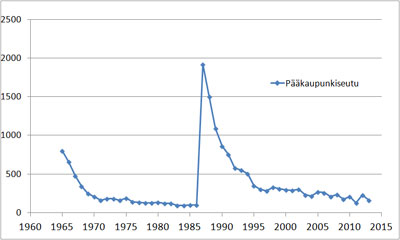Nuclear tests in the atmosphere
Fallout from past nuclear tests is still detected in Finnish nature. Altogether 512 nuclear tests have been performed in the atmosphere at a number of sites. Most of these tests took place between 1945 and 1963. The last nuclear tests were performed in 1980. The blasts generated plenty of different radioactive substances, their half-lives ranging from a few seconds to several thousand years.
Some of the substances entered the upper layers of the atmosphere due to the force of the blast or the original high altitude of the explosion, and over the years they gradually fell down to earth. The heaviest fallout was received after tests performed in the atmosphere in the early 1960s. With regard to radiation doses, the most important radioactive materials in the fallout are cesium-137 and strontium-90. Their presence in the soil, food and people has been monitored since the early 1960s.
Changes in the cesium-137 activity in Finns has also been followed through direct measurement of people. The highest cesium concentrations were detected in the mid-1960s, but before the Chernobyl accident, small amounts of cesium were still detectable in people. The average radiation doses were a few tenths of a millisievert.
In Finland, there is one group of people who received a clearly higher radiation dose from the cesium-137 in the nuclear test fallout: reindeer breeders in Lapland. They received cesium in food. The elevated cesium-137 activity in reindeer breeders is due to the fact that the food chain lichen–reindeer–human efficiently enriched cesium. From 1955 to 1985, cesium-137 exposed reindeer breeders to a dose of approximately 13 millisieverts (mSv), that is, 0.4 mSv per year. Their dose from other radioactive materials originating from nuclear testing totalled 0.3 mSv, that is, 0.01 mSv per year. Even today, reindeer breeders receive an annual dose of approximately 0.03 mSv from the cesium-137 originating from the nuclear test fallout.
The Cs-137 activity originating from the fallout from nuclear tests decreased from 1965 until 1986. In 1986, the Chernobyl accident raised the Cs-137 activity to its peak value, from which it has decreased to nearly the same level where it was before the accident.Changes in cesium-137 activity in people in the Helsinki Capital Region from 1965 to 2014. Until 1986, the cesium came from the fallout caused by nuclear weapon testing in the atmosphere. Since 1986, almost all of it has come from the fallout caused by the Chernobyl accident.
